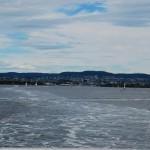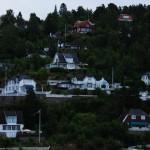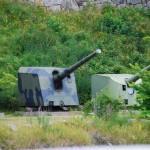With just under four days in Norway, there was no way for a visit to see the fjords, which are almost synonymous with Norway, as they are in the far west. But Oslo sits on the northern part of the Oslo fjord, even if it is not as majestic as the western fjords.
So, we decided to take a ride through the fjord, by a ferry. We took the ferry number 602, that starts off at the port at Aker Brygge, close to the City Hall and the Nobel Peace Centre. The ferry goes to the famous Drobak, and farther down to Son before returning to Oslo.

Oslo Fjord
It is a two-hour trip just one way, and if you are spectacled, like me, ensure yours are not the lighter variety as the ferry picks up speed and if it is windy, there is a chance your glasses might fall of or, in the worst case, even fly away (it did happen to me once, in Toronto!)
The ferry passes through a number of small islands, where it stops to drop off and pick up passengers.

Oslo Landscape
The ride gives you an idea of the landscape of the capital and its surrounding areas, may be even an inkling of Norway’s beauty. Along the way, there were thickly wooded areas and hills, jotted by holiday cottages or even apartments and houses, all built up in the typical Scandinavian fashion with different colours. There are tiny islands and islets, with a few homes or nothing but green.
The major attraction obviously is Drobak, which is located in the narrowest point of the Oslo Fjord. It used to be an important maritime city, functioning as the winter-time
port replacement for the Oslo port. It appears to be a cosy little town ideal for a day or two. I say ‘appears’ because I did not set foot due to time constraints. You can get more information from their very friendly website.
The other attraction certainly is the Oscarsborg Fortress, located on another island near Drobak.

Oscarsborg Fortress
This used to be one of the coastal fortresses setup to protect Oslo, and it showed its potential in 1940 during the Second World War, when the guns and the torpedoes installed there sank a German cruiser, giving time for the Norwegians to relocate their King and the government to a safer place away from imprisonment by the Nazis.
Later, it continued to function as a defence line against any potential Soviet-led threat against Oslo, but since then has been gradually decommissioned to its present status as simply a touristic and conference venue.
